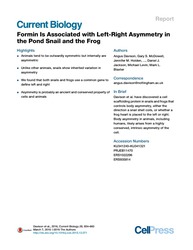Formin Is Associated with Left-Right Asymmetry in the Pond Snail and the Frog
Davison, Angus
McDowell, Gary S.
Holden, Jennifer M.
Johnson, Harriet F.
Koutsovoulos, Georgios D.
Liu, M. Maureen
Hulpiau, Paco
Van Roy, Frans
Wade, Christopher M.
Banerjee, Ruby
Yang, Fengtang
Chiba, Satoshi
Davey, John W.
Jackson, Daniel J.
Levin, Michael
Blaxter, Mark L.
26, 5: 654 - 660
DOI: https://doi.org/10.1016/j.cub.2015.12.071
Persistent URL: http://resolver.sub.uni-goettingen.de/purl?gldocs-11858/6914
Persistent URL: http://resolver.sub.uni-goettingen.de/purl?gldocs-11858/6914
Davison, Angus; McDowell, Gary S.; Holden, Jennifer M.; Johnson, Harriet F.; Koutsovoulos, Georgios D.; Liu, M. Maureen; Hulpiau, Paco; Van Roy, Frans; Wade, Christopher M.; Banerjee, Ruby; Yang, Fengtang; Chiba, Satoshi; Davey, John W.; Jackson, Daniel J.; Levin, Michael; Blaxter, Mark L., 2016: Formin Is Associated with Left-Right Asymmetry in the Pond Snail and the Frog. In: Current Biology, Band 26, 5: 654 - 660, DOI: 10.1016/j.cub.2015.12.071.
 |
Dokument öffnen: |
While components of the pathway that establishes
left-right asymmetry have been identified in diverse
animals, from vertebrates to flies, it is striking that
the genes involved in the first symmetry-breaking
step remain wholly unknown in the most obviously
chiral animals, the gastropod snails. Previously,
research on snails was used to show that left-right
signaling of Nodal, downstream of symmetry
breaking, may be an ancestral feature of the Bilateria
[1, 2]. Here, we report that a disabling mutation in
one copy of a tandemly duplicated, diaphanousrelated
formin is perfectly associated with symmetry
breaking in the pond snail. This is supported by the
observation that an anti-formin drug treatment converts
dextral snail embryos to a sinistral phenocopy,
and in frogs, drug inhibition or overexpression by
microinjection of formin has a chirality-randomizing
effect in early (pre-cilia) embryos. Contrary to expectations
based on existingmodels [3–5],wediscovered
asymmetric gene expression in 2- and 4-cell snail embryos,
preceding morphological asymmetry. As the
formin-actin filament has been shown to be part of
an asymmetry-breaking switch in vitro [6, 7], together
these results are consistent with the view that animals
with diverse body plans may derive their asymmetries
from the same intracellular chiral elements [8].
Statistik:
ZugriffsstatistikSammlung:
- Geologie [933]


